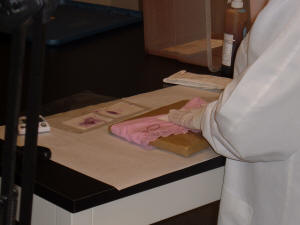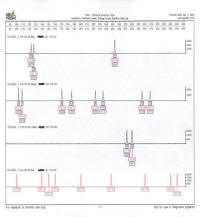FORENSIC BIOLOGY/DNA
Forensic Biology is
the area of the crime laboratory dedicated to finding and classifying
body fluids and biological substances from crime scenes. The
forensic biologist takes detailed notes, performs tests and collects and
preserves an appropriate amount of the evidence for subsequent testing.
Tests for body
fluids utilize chemical, enzymatic and microscopical techniques.
The body fluids most commonly tested for in the laboratory are blood,
saliva and semen. “Presumptive” tests indicate a body fluid may be
present. Preliminary chemical tests for body fluids usually
involve a color change. A small amount of blood – as little as a 1
to 1 million dilution – creates a fast blue/green color change with the
Tetramethylbenzidine (TMB) test. The chemical is reacting to the
iron molecule in red blood cells. This means that there is an
indication that blood is present, but there may be a few other
alternative explanations, even if they are less likely.
Presumptive tests
for saliva look for a chemical called amylase. Amylase is an
enzyme that begins breaking down starches in the mouth. A small
amount of the sample is placed in a gelatin that contains starch and is
allowed to incubate overnight. If amylase is present, it will
begin working its way outward from the center well where it was placed,
consuming the starch as it radiates out. Since the chemical iodine
will turn starch blue, an iodine solution is then added to the plate.
Where starch has been consumed, a clear circle is observed. The
diameter of the circle is proportional to the amount of amylase that is
present, indicating saliva.
 |
|
AP Press
Out on Clothing |
Acid phosphatase, or
AP, is an enzyme that is found in many body fluids, but is at its
highest concentration in semen. This presumptive test also
requires a fast change to the color purple. The presence of semen, the
male reproductive fluid, can be identified by either the presence of
sperm cells or by the presence of relatively large amounts of Prostate
Specific Antigen, also known as PSA. Sperm are identified using a
stain and visually observing them through a microscope.
Usually, evidence is
not forwarded for DNA analysis unless a body fluid is identified.
Contact DNA from handled items is impossible to detect prior to
expensive and time-consuming DNA testing. There are four basic
steps in the DNA procedure: extraction, quantification,
amplification, and detection.
The extraction
procedure breaks open the cells containing DNA. It is important to have
the DNA in a liquid environment where it can flow and move, and thereby
interact with other chemicals that are used to test it. After the
DNA is released into the water, the sample is purified and concentrated
by removing excess water.
After the sample is
extracted, the analyst determines if there is any DNA in the liquid, and
if so, how much. The reaction of the extract is compared to the
reaction of a series of standards with known concentrations, called a
serial dilution. Based on this comparison, a rough estimate can be
made about the quantity of DNA present.
 |
|
Electropherogram |
The amplification
process, known as PCR (Polymerase Chain Reaction), targets specific
areas of the DNA and makes many copies of it. By looking at only
13 different locations in the DNA, enough characteristics can be
identified so that it becomes highly unlikely the DNA is from two
different randomly selected individuals.
In the final step,
detection of DNA products, only the STRs (Short Tandem Repeats) of
interest are observed because during amplification, a small chemical was
added to the DNA copy. This chemical will glow when a particular
kind of laser shines on it. The flash of light from the chemical
is captured by a digital camera and is displayed as a peak on print-outs
called “electropherograms”.
The DNA profile
obtained from the crime scene sample can then be compared to the DNA
profile from a known individual or it can be entered into a computer
database called Combined DNA Index System or
CODIS. This database
contains DNA profiles from convicted felons, from other crime scene
samples, from unidentified human remains and from other sources.